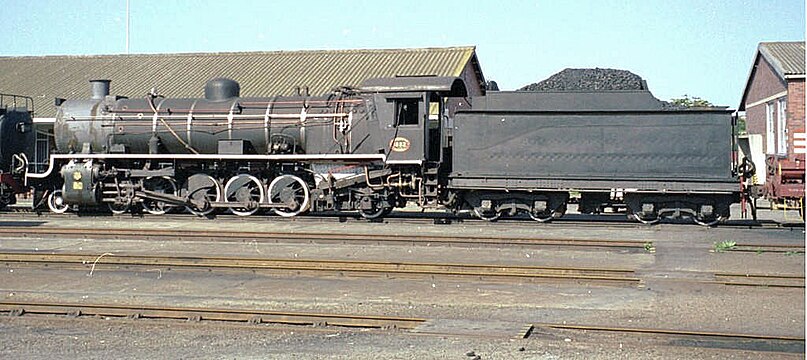South African type LP tender
 Type LP tender on SAR Class MJ1, c. 1920 | |||||||||||||||||||||||||||||||
| |||||||||||||||||||||||||||||||
| |||||||||||||||||||||||||||||||
| |||||||||||||||||||||||||||||||
The South African type LP tender was a steam locomotive tender.
The Type LP tender first entered service in 1918, as tenders to the Classes 14C, 15B and MJ1 steam locomotives which were acquired by the South African Railways from Canada in that year.[1][2][3]
Manufacturer[edit]
Type LP tenders were built between 1918 and 1922 by Montreal Locomotive Works in Canada.[1]
The South African Railways (SAR) placed eight Class MJ1 2-6-6-0 Mallet, 73 Class 14C 4-8-2 Mountain and thirty Class 15B 4-8-2 Mountain type locomotives in service between 1918 and 1922. The locomotives and tender were designed by Montreal Locomotive Works, to the specifications of D.A. Hendrie, Chief Mechanical Engineer of the SAR. The Type LP tender entered service as tenders to these three locomotive classes.[1][2][3][4]
Characteristics[edit]
As built, the tender had a coal capacity of 10 long tons (10.2 tonnes) and a water capacity of 4,250 imperial gallons (19,300 litres), with an average maximum axle load of 12 long tons 14 hundredweight 2 quarters (12,930 kilograms).[1][2][3][4]
Locomotives[edit]
Only the Classes MJ1, 14C and 15B were delivered new with Type LP tenders, which were numbered for their engines in the number ranges as shown. An oval number plate, bearing the engine number and often also the tender type, was attached to the rear end of the tender.[1][3]
- 1918: Class MJ1, numbers 1666 to 1673.
- 1918-1922: Class 14C, numbers 1761 to 1780, 1881 to 1900, 1991 to 2010 and 2026 to 2038.
- 1918-1922: Class 15B, numbers 1829 to 1838 and 1971 to 1990.
Classification letters[edit]
Since many tender types are interchangeable between different locomotive classes and types, a tender classification system was adopted by the SAR. The first letter of the tender type indicates the classes of engines to which it could be coupled. The "L_" tenders could only be used with the three locomotive classes with which they were delivered.[2][3]
The second letter indicates the tender's water capacity. The "_P" tenders had a capacity of 4,250 imperial gallons (19,300 litres; 5,100 US gallons).[3]
Modifications[edit]
Most of these tenders were later modified by shortening and raising the upper sides of the coal bunker, in effect making the coal at the rear of the bunker more easily accessible to the stoker and apparently without affecting the tender's coal capacity.[3]
Illustration[edit]
-
Modified Type LP on Class 14CRB no. 1882, 1997
-
Modified Type LP on Class 14CRB no. 1766, 1979
-
Modified Type LP on Class 14CRB no. 2010, 2009
References[edit]
- ^ a b c d e Holland, D. F. (1972). Steam Locomotives of the South African Railways. Vol. 2: 1910-1955 (1st ed.). Newton Abbott, England: David & Charles. pp. 34–37. ISBN 978-0-7153-5427-8.
- ^ a b c d South African Railways & Harbours/Suid Afrikaanse Spoorweë en Hawens (15 Aug 1941). Locomotive Diagram Book/Lokomotiefdiagramboek, 3'6" Gauge/Spoorwydte. SAR/SAS Mechanical Department/Werktuigkundige Dept. Drawing Office/Tekenkantoor, Pretoria. p. 44.
- ^ a b c d e f g South African Railways & Harbours/Suid Afrikaanse Spoorweë en Hawens (15 Aug 1941). Locomotive Diagram Book/Lokomotiefdiagramboek, 2'0" & 3'6" Gauge/Spoorwydte, Steam Locomotives/Stoomlokomotiewe. SAR/SAS Mechanical Department/Werktuigkundige Dept. Drawing Office/Tekenkantoor, Pretoria. pp. 6a-7a, 45.
- ^ a b Paxton, Leith; Bourne, David (1985). Locomotives of the South African Railways (1st ed.). Cape Town: Struik. pp. 51–52. ISBN 0869772112.



